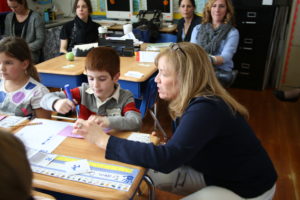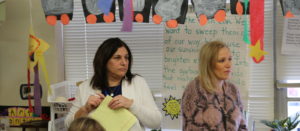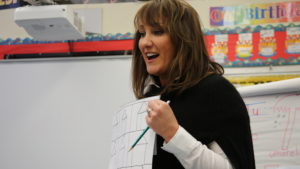Do Teachers Use Orton Gilling Ham in the Classroom for Reading Groups

First grade instructor Annette Farelli works with a student
Annette Farelli's first grade classroom at Bergen Boulevard School is cozy and calorie-free-filled. Colorful posters and children'southward artwork line the walls. 2 rows of minor desks dominate the room, each seating x. "Alright, E side, pound it with me," Farelli calls out, "Allow me hear it!" Pounding out sentences is but one role of Farelli's first class class's twenty-four hour period: she'southward also taken them through their paces with the blending board, sand trays and dictation.
At the same time, simply down in the hall in Martha Acebal'southward second grade classroom, students are working on their red words. "I go commencement, you listen," Acebal advises the form as she stands up and executes an arm tapping practise for a notorious red word, 'which.'
Bergen Boulevard is role of the Ridgefield School District in Ridgefield, New Jersey. Located simply over the Hudson from Manhattan, Ridgefield is a small, suburban enclave of roughly ten thousand. The kind of place where immature families looking to escape the noise and bustle of the big city caput to when they decide it's time to settle down.

Bergen Boulevard School in Ridgefield, New Jersey
The Ridgefield School District has some other describe for families: many come here for the District'due south special pedagogy programs. In fact, the Commune began training teachers in the Orton-Gillingham method about eight years ago to meliorate service elementary students with learning disabilities. A number of District teachers had too pursued Orton-Gillingham preparation at Fairleigh Dickinson University in Teaneck, NJ.
"And information technology was very successful with those kids," says Janet Seabold, Ridgefield Public Schools' Director of Curriculum. "Nosotros started a Response to Intervention program where we would do structured interventions with our regular education students in vi week blocks and then return them to the course and we found such great gains with them that we wanted to bring it to our mainstream population."
At the aforementioned time, particularly with changes in the state'due south English linguistic communication arts curriculum, Seabold says, teachers were likewise noticing gaps in the reading abilities of upper grade elementary students in general ed classrooms.
I was and so happy to encounter that IMSE took a program that was usually one-to-one with our special needs kids and made information technology so that information technology could be [used] in a regular ed classroom, as a whole class.
—Ridgefield Principal, Anna Gaeta
"As our students started to historic period, getting to the 5th, 6th grade level where you would be reading that non-fiction text and asking [them] to decode larger words in a science textbook, the kids didn't accept the skills to break downward those words," she says. Making matters worse, at that time, lower unproblematic grades were not spending much fourth dimension on dedicated phonics educational activity either.

Shaler Academy in Ridgefield, New Jersey
Past 2014, Principal Anna Gaeta, who oversees Bergen and its sis schoolhouse, Shaler University, home to Kindergarten classes, was routinely having discussions with members of the two schools' teaching staff about the gaps they were seeing in students' skills. She began seeking out professional training that could help teachers address the growing need in general instruction reading instruction. That summer, she sent ten teachers who volunteered during their summer vacation to accept IMSE'south Comprehensive Orton-Gillingham 30 Hour grooming.
There has to exist an agreement of how language works. And this program gives our students, in a very basic and fun fashion, an understanding of how language works. Those understandings go into their toolbox.
—second Class Teacher, Bergen Blvd. Schoolhouse, Martha Acebal
"They came back so enthusiastic about all the great strategies they had learned," Gaeta says. Soon after, other teachers were asking almost attention a preparation.
During the 2014-2015 school year, IMSE's Orton-Gillingham program was piloted in Ridgefield Kindergarten classes. Post-obit the trial, the District created a sub-committee to review IMSE and 2 other reading programs. "The commission felt [IMSE's] program best met the needs of a larger classroom. Y'all could differentiate the didactics for the kids who could learn quicker, who didn't need the tenets of the decoding and the word breakdown skills equally much as those kids who do," Seabold says.
With the vote from the pick sub-committee and the support of Ridgefield School Superintendent, Frank Romano, Bergen Boulevard and Shaler Academy schoolhouse administrators began exploring implementing IMSE's Orton-Gillingham program across the curriculum in grades G, 1 and two for the 2015-2016 school year. To prepare, twenty teachers from the District attended IMSE's 30 Hour Comprehensive Training in June of 2015.
First grade teacher Annette Farelli and second grade teacher Martha Acebal were among the teachers who attended the training.
The training was Farelli's first exposure to Orton-Gillingham. "The training was challenging, simply exciting at the same time, because I felt like I was getting clues on how to give these strategies to the students that you didn't quite know how to get to earlier," Farelli says.

Ridgefield 2nd Grade instructor Martha Acebal leads her class in an arm tapping exercise
Martha Acebal was familiar with the Orton-Gillingham method, simply was impressed by the multi-sensory aspect of the plan, which she feels helps integrate lessons more firmly in students' memories. "Annihilation that's kinesthetic, whether it'southward a tactile sand tray, or getting them up, tapping, finger borer, pounding, because at this age, the young ones, they demand to move. So, I think it really anchors their learning in a mode that you know, if they just heard it, or if they just saw it, by having their whole bodies involved…it's astonishing," Acebal says.
Ridgefield teachers and administrators were too pleased with the practical nature of IMSE's plan. "You lot know, information technology's ane matter to be working 1-on-one or two-on-one or in a small grouping. But when yous accept to take the theories to a group of xx-five kindergarteners and keep them on job and focused and learning, information technology's a whole unlike thing," Seabold says.
It's non every bit much fun to read a science textbook equally information technology is to read Harry Potter. And the kids needed those skills…what this does is to requite the kids the skills to read the words that are not as fun to read.
—Ridgefield Schools Managing director of Curriculum, Janet Seabold
Teachers liked that IMSE's program helped break out mean solar day-by-day lesson plans in a sequential, organized style. "This plan was applied, proven to work in the classroom, which is a big slice with our teachers. Because if they don't really care for it, they're not going to use it. But they really meet the benefits, that'south why they're using it," Principal Gaeta says.
Perhaps another surprising do good of using IMSE's Orton-Gillingham in the general ed classroom is how it helps stiff readers in get-go and second gradeget even stronger.
"The i component that'south especially exciting to me is syllabification, and what I'm finding is that the advanced readers are loving this because at present they're tackling those tough words. And non-fiction reading has get such an important component specially with the Common Core…they're tackling these big challenging words, that normally they wouldn't have," Farelli says.
Ridgefield curriculum director Janet Seabold agrees that fifty-fifty strong readers can benefit from dedicated instruction on word decoding. And that merely immersing children in books during the early grades isn't enough. "Information technology'south non as much fun to read a science textbook as it is to read Harry Potter. And the kids needed those skills. What this does is to give the kids the skills to read the words that are non as fun to read," Seabold says.
For Martha Acebal, IMSE'due south Orton-Gillingham program provides the foundational skills that all young readers need. "There has to exist an understanding of how language works. And this program gives our students, in a very basic and fun way, an understanding of how language works. Those understandings go into their toolbox," Acebal says.
Some other meaning do good of using Orton-Gillingham in the general ed classroom is early detection for students struggling with dyslexia, auditory processing or other reading disabilities. Dawn Galbraith-Mazzola is a Response to Intervention (or RTI) Specialist for Ridgefield schools. "Nosotrosstarted the mandatory second class dyslexia red flag screening this year," Mazzola says.
New Jersey, like many states across the land, are now requiring school districts to provide both dyslexia screening and intervention services for students by 2d grade.
But prominent reading researchers and dyslexia experts like Sally Shaywitz, founder of The Yale Eye for Dyslexia and Creativity, have argued that dyslexia can be detected as early as Kindergarten.
For more about the findings of Shaywitz and other researchers, click here: http://dana.org/Publications/Brainwork/Details.aspx?id=43792
Past implementing IMSE'southward Orton-Gillingham beyond all Thousand, 1 and 2 classrooms, Galbraith-Mazzola says the commune will take a jump on early diagnosis, to a higher place and beyond the state-mandated testing. "Nosotros tin kickoff interventions two years earlier; that's pretty amazing to be able to start interventions that much earlier and solve that result. Information technology'due south something that we can close early on instead of them coming up into 3rd and fourth course and so we're finding that they're 2 deviations from the norm."
What IMSE does is information technology reaches across all those barriers, it reaches all students.
—Ridgefield Schools Director of Curriculum, Janet Seabold
And considering all children are taught in IMSE'due south Orton-Gillingham method, there's more allegiance of instruction for students who practice receive one-on-one pedagogy—they will go into resources rooms already familiar with the concepts of phonemes and the practice of tapping out syllables.
During her testing of Kindergarten students at the end of 2015, Galbraith-Mazzola constitute that after vi months of OG teaching in Ridgefield's general ed classrooms, students were already applying the strategies they had learned in settings exterior of their regular classes. "The biggest matter was in the phoneme partitioning section of the test where I would inquire them to break a word into parts. For instance if I said the word cat, I would enquire them to break it down into the sounds /thou/ă//t/. They were tapping it, without me asking them to. They were using the strategies, which shows that they're generalizing them into different settings, which is a higher skill for them."

Ridgefield Kindergarten instructor, Lillian Pagano, at left
For Kindergarten teacher Lillian Pagano, IMSE'south arroyo to Orton-Gillingham offers helpful tools for differentiation with the district's youngest students, who present a unique challenge for educators. "One of the things that I dear about education kindergarten, but ane of the nearly challenging things about kindergarten, is the children come in at all different levels. We have children that practice not know how to write their name, don't know a letter, don't know a audio, and you have children that are emergent readers," Pagano says.
IMSE lessons can be tailored to provide that differentiation in instruction, so crucial in Kindergarten and the early elementary grades. By creating small group 'centers,' teachers can hone in on alphabetic character formation or provide targeted phonemic teaching to students who are yet getting their basic skills down. "Nosotros create centers, and in the centers, the children themselves are reinforcing the skills that they've learned, and again, in a very fun and engaging manner. I don't need to be on superlative of them all the fourth dimension like you are when y'all do straight instruction," Martha Acebal says.
Across Ridgefield's large concentration of special needs students, the district is quite ethnically various—29% of students are Asian and 34% are Hispanic. "What IMSE does is it reaches beyond all those barriers, it reaches all students," Seabold says. The methods of Orton-Gillingham, with a focus on phonics and systematically breaking downwardly words and sentences overlaps nicely with a purely phonetic language like Spanish.
For more about IMSE and ELL educational activity, click here: https://journal.orton-gillingham.com/ell-students-do good-from-orton-gillingham-techniques/
Aside from the applied aspects of IMSE'south Orton-Gillingham program, teachers and administrators love the ongoing support and opportunities for continued professional growth they receive.
"We liked [IMSE] considering in that location was a large component of professional development that went with it. And studies do show that a well-informed teacher is the best resource. Then, that was a very important part of our determination was that it would benefit the teachers because there was a ongoing professional evolution along with it," Galbraith-Mazzola says.
Teachers point to the added benefits that IMSE provides with its email newsletter, OG Weekly and the IMSE lesson planning app teachers can download onto their phone or tablet. "The weekly newsletter is a very skill specific item and it just gives you lot just enough information. There was a week I wasn't reading the Red Words up and down and dorsum and along and it was simply a self-check for me to say 'Oh my gosh, yes, that was a adept thought, I should go dorsum to that," Farelli says.

Jeanne Jeup, IMSE director and co-founder
Ongoing visits from IMSE staff have also been a large help to Ridgefield teachers. "It's been great to see Jeanne come in and step by step walk united states of america through what a word dictation looks like, what at three-office drill is, review all these things that we learned. We come in and the teachers sit there and they have notes during our lessons, and then we can question her," Pagano says.
Ridgefield's comprehend of OG is extending beyond the classroom, besides. "Our parents are involved. They know the terminology. They know what a Ruby-red Word is, a Green Word is. They know what they should exist trying to do at domicile if they exercise notice that their child is struggling with a particular discussion. So over again, everybody's involved, that's wonderful," Acebal says.
In but ane year, Ridgefield schools have already seen great reading gains among students in grades K, 1 and 2. For teachers like Martha Acebal, information technology'southward been exciting journeying that Ridgefield educators are excited most continuing, "Come back. Run into how we're doing. Perchance let'south hash out some other things that nosotros could be doing."
Only every bit students acquire new strategies to brand them stronger readers, educators trained in IMSE'due south Orton-Gillingham method find their professional growth enriched as well.
"The day I stop learning, there'due south a problem. And with IMSE coming in, I've learned a whole new component of how to reach something that was a challenge for me as a professional. It is a journey, but it's a journey worth taking. And I'm nevertheless evolving, but I'm excited when I see my students getting it," Farelli says.
For more data most Ridgefield schools, cheque out: http://world wide web.ridgefieldschools.com/
bullardsymaine1985.blogspot.com
Source: https://journal.imse.com/orton-gillingham-in-the-general-education-classroom/
0 Response to "Do Teachers Use Orton Gilling Ham in the Classroom for Reading Groups"
แสดงความคิดเห็น